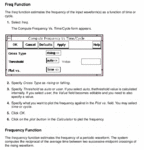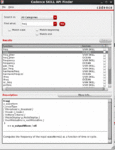etmsni
Junior Member level 1

[Moved]:[Cadence Virtuoso ADE Calculator] Difference btw Freq and Frequency Function?
I'm trying to find the period of a waveform in Cadence Virtuoso ADE using the calculator function. I see in the user manual that there's two things(please see below picture): (1) Freq function (2) Frequency Function

What's the difference between those two? My guess is that "Freq" function is instantaneous frequency, and "Frequency Function" is like frequency over a period?
Thank you!
I'm trying to find the period of a waveform in Cadence Virtuoso ADE using the calculator function. I see in the user manual that there's two things(please see below picture): (1) Freq function (2) Frequency Function

What's the difference between those two? My guess is that "Freq" function is instantaneous frequency, and "Frequency Function" is like frequency over a period?
Thank you!



